Grating Edit window
( Modeling > F2 > "  Misc steel " > " Grating ")
Misc steel " > " Grating ")
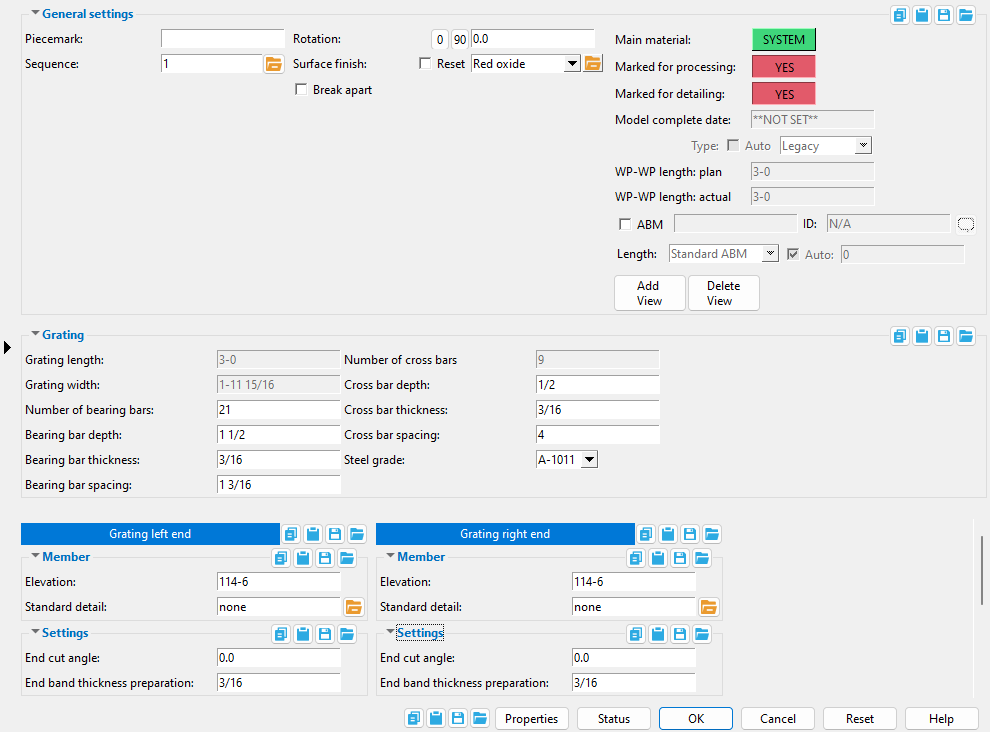
Selecting " Grating " as the "  Miscellaneous steel " type adds a custom member with grating material to a 3D model.
Miscellaneous steel " type adds a custom member with grating material to a 3D model.
The Grating custom member is a superior alternative to " Miscellaneous -- Grating ."
The edit window of this member features material and member options on the same window.
Its " General settings " include " Break apart " and " Rotation ," which are not available for the legacy miscellaneous member.
Member operations such as many of those found on the Model > Member menu in Modeling can be performed on this member, and you can add custom components to it.
- Special indicators:


The " OK " button is disabled (grayed out) to indicate a validation error. Hover the " OK " button with your mouse pointer to get a listing of settings you need to change on this window. When all settings are valid, the " OK " button is enabled. 

Red-colored highlighting identifies an entry that is invalid. You need to change that setting, or you will not be able to close this window using " OK ."
Also see :
- Material Types (topic)
- Miscellaneous member types (the complete list)
- Custom members (a grating miscellaneous member is a custom member)
- Grating Material (window can set Grating Edit 's " Main Material " to ' USER ')
- Miscellaneous members versus legacy miscellaneous members (topic)
- Surfaces Connection (a custom component you can add to a miscellaneous member)
1 . A grating miscellaneous member can be properly located and rotated even in an isometric view. Before adding the member, be aware of the following:
2 . To add a grating miscellaneous member (in Modeling ):
Alternative 1 : Press F2 > check the box for "
Miscellaneous steel " > double-click " Grating ."
Alternative 2 : Choose Model > Member > Prompt for Member Type > check the box for "
Miscellaneous steel " > double-click " Grating ."
3 . Locate - Repeat - Return mouse bindings become active, and you are prompted to locate the grating member's work points. Two work points are required to lay out grating. Generally, grating is placed in a plan view at a " Rotation " of ' -90 ' degrees (the default).
|
|
|
bindings |
3a : Select the appropriate Locate option.
3b : Left-click ( Locate ) at two different on-screen positions to define the member line between those two points. The first work point you enter when you add the grating defines the left end of the member. Both points are represented as exact points after step 4, when the member is actually generated in the model.


The first point that you locate is identified by an origin symbol . The origin symbol also tells you which end is the member's left end.
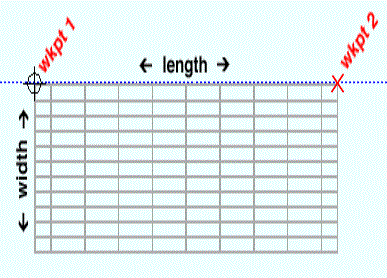
When the " Rotation " of the grating is ' -90 ', its bars are placed above the work plane. If you Model > Member > Isolate > ... a grating miscellaneous member, you will find that the member's MAIN VIEW shows the member's origin symbol (
) to be to your left. This is true for any miscellaneous member -- even if the origin symbol for the member is to your right in a plan view. The MAIN VIEW in member isolation directly correlates to the main view of the miscellaneous member's detail.
Best practice when adding a miscellaneous member in a plan view is to input the member from left to right or from bottom to top. That way, when you add a grid line from left to right, the near side of the member, as determined by the location of its left end , will be the side looking toward the bottom or toward the right of the screen.
4 . The Grating Edit window opens. On it are settings for the grating material you are adding.
4a : Specify the " Number of bearing bars ," the " Bearing bar depth ," " Bearing bar thickness ," " Bearing bar spacing ," " Cross bar depth ," " Cross bar thickness " and " Cross bar spacing " or use the defaults.
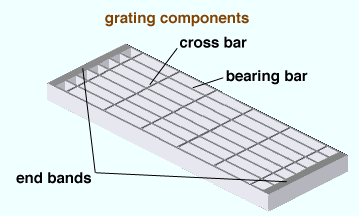
4b : Press the " OK " button at the bottom of the window to apply your settings and close this window.
Note: The default settings on this window are those of the last grating miscellaneous member added or edited in this session of Modeling . Even if all you do is double-click a grating member and press " OK " on its edit window, its settings become the defaults for the next-added grating miscellaneous member. You therefore only need to make changes to those settings which are different for this member.
5 . If User and Site Options > Modeling > " Automatically process after modeling operation " is ' Process and create solids ', the new grating will have automatically undergone all phases of Process and Create Solids and will show up in a solid form . If that option is ' Process ' or ' Do nothing ', then the member line of the grating you just added shows up on screen in stick form , and you will have to Process > Process and Create Solids in order to have the member piecemarked and able to be displayed in a solid form. Do one (1) of the following:
|
|
|
bindings |
Alternative 1 : Move the mouse pointer (
) and middle-click ( Repeat ) to lay out grating just like the last one beginning at the point where the point location target (
) is at. The X, Y global axes location of the repeated grating will begin from the located repeat point (where the target is at). The plate's Z location and other settings will be that of the last-added or last-edited grating.
Alternative 2 : Follow these instructions beginning with step 3 to add grating with different settings than the one you just laid out.
Alternative 3 : Right-click ( Return ) if you are done adding grating.
------ Grating ------
Grating length: This is a read-only information field that tells you the actual length (in the primary dimension " Units " or other units ) spanned by the grating's member line.
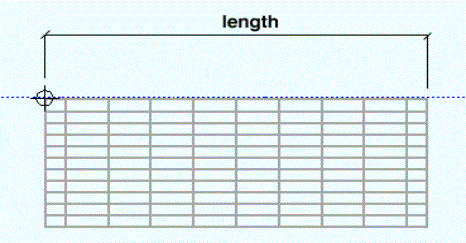
Note: Length is added to/subtracted from the end of the grating that is opposite to the left end . Changing this distance adjusts the " Number of cross bars " while keeping their thickness and spacing the same.
The following can be used to track the choice made here when " Main material " is ' SYSTEM ':
Report Writer: XXXXX . Length
Advanced Selection: Length
Parametric module: Length
Grating width: This is a read-only information field that tells you the width (in the primary dimension " Units ") of the grating.
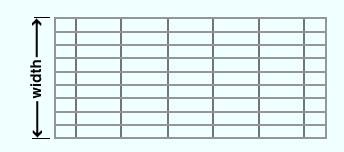
Note: Grating width is calculated based on the following formula: grating width = [( number of bearing bars - 1)( bearing bar spacing )] + bearing bar thickness . This means that if you change the " Number of bearing bars " or " Bearing bar spacing " or " Bearing bar thickness ," the grating width will be recalculated.
The following can reveal the choice made here when " Main material " is ' SYSTEM ':
Report Writer: XXXXX . Width
Advanced Selection: Width
Parametric module: Width
Number of bearing bars: The total quantity ( 1 or 2 or 3 or ...) of bars that are parallel with the grating's member line.
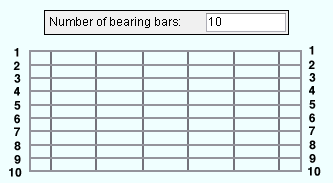
Note: Changing the number of bearing bars entered here changes the " Grating width ." Each bearing bar is as long as the length of the grating.
The following can read and output the choice made here when " Main material " is ' SYSTEM ':
Report Writer: XXXXX . NumberOfStringersInGrate
Report Writer: NumberOfStringersInGrate
Bearing bar depth: The depth (in the primary dimension " Units " or other units ) of any one bearing bar. This dimension is measured perpendicular to the member line of the grating. All bearing bars will be this same depth. The end bands will also be this same depth.
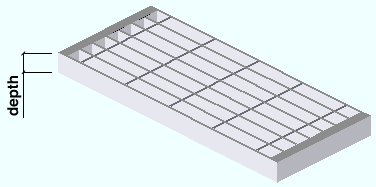
The following can be used to show the choice made here when " Main material " is ' SYSTEM ':
Report Writer: XXXXX . BearingBarWidth
Report Writer: BearingBarWidth
Bearing bar thickness: The thickness (in the primary dimension " Units " or other units ) of any one bearing bar. All bearing bars will be this same thickness.
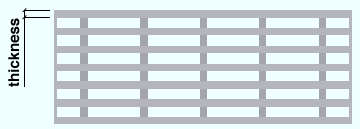
Note: Changing the thickness entered here causes the " Grating width " to be recalculated.
Fabricator Setup: Add bearing bar thickness to grating description ( Member Detailing Settings )
The following can be used to track the choice made here when " Main material " is ' SYSTEM ':
Report Writer: XXXXX . BearingBarThickness
Report Writer: BearingBarThickness
Bearing bar spacing: The distance (in the primary dimension " Units " or other units ) between any one bearing bar and the next bearing bar plus the thickness of the one bearing bar.
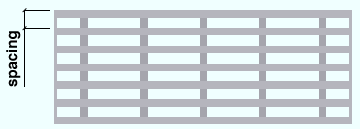
Note: Changing the spacing between bearing bars that is entered here causes the " Grating width " to be recalculated.
The following can be used to track the choice made here when " Main material " is ' SYSTEM ':
Report Writer: XXXXX . BearingBarSpacing
Advanced Selection: BearingBarSpacing
Parametric module: BearingBarSpacing
Number of cross bars: read-only . This tells you the number ( 1 or 2 or 3 or ...) of bars that are perpendicular to the grating's member line, not including the end bands.
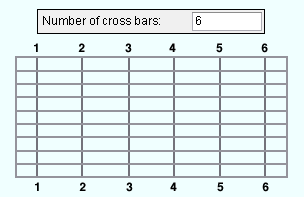
Note: To change the number of cross bars that is entered here, you can adjust the " Grating length " or change the " Cross bar spacing " or " End band thickness ."
Cross bar depth: The distance (in the primary dimension " Units " or other units ) measured perpendicular to the member line of the grating tread between the top and bottom edges of any one cross bar. All cross bars will be this same depth.
Example: For grating laid out in a plan view, this distance is the difference between the elevation of the top of a cross bar and the bottom of that same cross bar.
The following can track the choice made here when " Main material " is ' SYSTEM ':
Report Writer: XXXXX . CrossBarWidth
Cross bar thickness: The thickness (in the primary dimension " Units " or other units ) of any one cross bar. All cross bars are this same thickness.
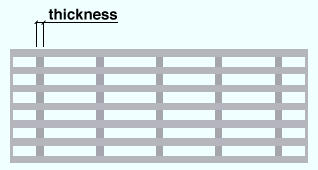
The following can reveal the choice made here when " Main material " is ' SYSTEM ':
Report Writer: XXXXX . CrossBarThickness
Cross bar spacing: The spacing (in the primary dimension " Units " or other units ) from the center of one cross bar to the center of the next cross bar. In the illustration below, this is the spacing between the one cross bar and the next cross bar plus the thickness of the one cross bar.
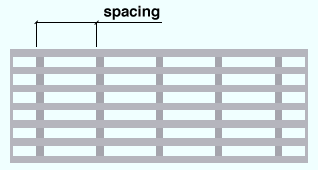
Note: Changing the spacing of the cross bars that is entered here may cause the " Number of cross bars " to be recalculated. For instance, if you were to increase the cross bar spacing, the " Number of cross bars " might decrease since the " Grating length " would remain the same.
The following can read and output the choice made here when " Main material " is ' SYSTEM ':
Report Writer: XXXXX . CrossBarSpacing
Steel grade: The steel grades that you can select in this list box ( ![]() ) come from Home > Project Settings > Job > Grating Grades . Since connection design does not reference the steel grade applied to a grating tread, there are no Fy and Fu values on that setup window.
) come from Home > Project Settings > Job > Grating Grades . Since connection design does not reference the steel grade applied to a grating tread, there are no Fy and Fu values on that setup window.
The following can show the choice made here when " Main material " is ' SYSTEM ':
Bill of material: Steel Grade
Status Display: Member status > Steel grade
Advanced Selection: MaterialGrade
Parametric module: MaterialGrade
|
|
|
------ Member ------
End elevation: The elevation (in the primary dimension " Units " or other units ) of the work point at this end of the grating. For a non-sloping grating, both the left and right end elevations are the same. When you add the rolled grating, its work points are placed in your current view's reference elevation until you change their elevations here, on this window.
| Grating has four exact points . You can choose the elevation of the two along its member line by changing the member's left- and/or right-end " End elevation ." |
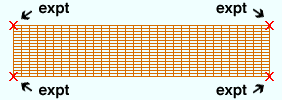
|
To determine the end elevation on grating in the 3D model , use Construction Line Add or a similar tool, select EXPT as the Locate option, then snap the point location target to the work point at the end of the member. The Z coordinate reported in the X-Y-Z display tells you the elevation at the snapped-to exact point.
Tip: You should use this option instead of rotating a grating member's material to change its left- or right-end elevation. For complex situations, you can Model > Member > Move/Stretch one or the other of its work points.
Standard detail: None or a standard detail name . To apply a standard detail, you can type in the file name of the drawing (if you know it), or press the "file cabinet" browse button ( ![]() ) and double-click any job standard detail or global standard detail that is on the list.
) and double-click any job standard detail or global standard detail that is on the list.
If ' none ' is entered here, then no standard detail will be applied on this end of the miscellaneous member when it is automatically detailed .
If a ' standard detail name ' is entered here, the next time you auto detail this miscellaneous member, the reference point of the standard detail will align with the input work point on this end of the member, and the standard detail's bill of material will be combined with the member's bill of material. The detail is placed on a layer that is named after the standard detail plus a "_L" or "_R" suffix.
------ Settings ------
End cut angle: Any angle from 89 to -89 degrees. The cut will be made along the width of the grating.
For example, assuming that the left end of the decking is to your left on your computer screen and negative distances along its Y member axis are toward the bottom of the screen: ' 0 ' (zero) square cuts the end. A ' positive angle ' is measured counterclockwise from a perpendicular bisector to the member line. A ' negative (-) angle ' is measured clockwise from a perpendicular bisector to the member line.
The following can reveal the choice made here when " Main material " is ' SYSTEM ':
Report Writer: XXXXX . LeftEndCutAngle
Report Writer: XXXXX . RightEndCutAngle
End band thickness preparation: The thickness (in the primary dimension " Units " or other units ) of the left/right end band.
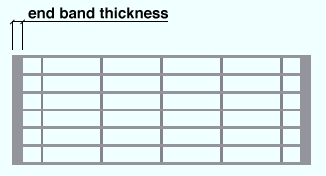
Note: Changing the thickness that is entered here may cause the " Number of cross bars " to be recalculated.
The following can track the choice made here when " Main material " is ' SYSTEM ':
Report Writer: XXXXX . LeftEndBandThickness
Report Writer: XXXXX . RightEndBandThickness
Advanced Selection: EndBandThickness[0] or EndBandThickness[1]
Parametric module: EndBandThickness[0] or EndBandThickness[1]







